1. Introduction
Urban sprawl is typically used to describe low-density suburban development around the periphery of cities [
1]. The understanding of urban sprawl can be traced to its alternative terms such as “urban growth” and “urban expansion”. On one hand, urban growth has been defined in a broader sense including either an expansion of population, or economic activity within an urban area [
1]. Brueckner has taken the term “urban sprawl” as the excessive spatial growth of cities [
2]. Glaeser and Kahn argued that urban growth is realized through sprawl, and urban growth and urban sprawl were almost synonymous in their work titled “Sprawl and urban growth” [
3]. On the other hand, there is another school of thought that urban sprawl is the inefficient or excessive urban expansion, resulting in a large loss of amenity benefits or natural resources [
4,
5,
6]. This opinion has been fashionable in China as the encroachment of farmland is largely ascribed to the expansion of urban space [
7,
8,
9]. Meanwhile, sprawl is also been identified as one of the five types of urban expansion by Camagni
et al., which is characterized by new scattered development lots [
10]. As a result, to some extent, urban sprawl is regarded as a featured form of urban expansion or urban growth, and these expressions are interchangeable with each other in many cases [
11]. In our study, in order to clarify the following analyses, we here define urban sprawl in a wider sense, including spatial growth or expansion, as well as the scattering of associated human activities, from city centers to the outer periphery.
Since China’s economic reform, in particular land reform, urban sprawl is taking place in most Chinese mega-cities and has transformed them into more dispersed and multi-centered urban forms [
12,
13]. This is accomplished by the expansion and dispersion of built-up land towards suburban regions and most of newly built-up areas are converted from agricultural lands [
14,
15]. In China, the magnitude of built-up land or the Jianchengqu sprawling has evidently outstripped the urban population expansion and we are experiencing a land dominated sprawling era. Jianchengqu is regarded as the delineation of a specific area which has been constructed and equipped with the necessary infrastructure around the urban center. It is also asserted that urban sprawl is largely driven by the policies formulated by local government with the intention to stimulating local economic growth [
16,
17]. Here we would like to introduce three institutions or policies closely related to urban sprawl. First of all, in the past several decades, we have experienced extensive campaign to transform urban structure through setting up various development zones such as Special Economic Zones, Special Economic Development Zones, High-tech Development Zones and Industrial parks [
12,
18]. Secondly, the establishment and development of land market make the lease of the land available from local government and realize the decentralization of economic development to a large scale [
17]. Thirdly, with the implementation of national project of “transforming county into urban district” to accelerate an overall metropolitan development, intra-urban structures have undergone tremendous changes and previous counties or districts with rural characteristics have gradually turned into more urbanized area. Bhatta argues that reliable sprawl measurements are highly demanded in consideration of the end users who are city administrators and planners. Hence, the quantification of urban sprawl is expected to accommodate these administrative and institutional contexts, which has not yet been fully realized in the previous research. This is essential in China, as the role of government has been more direct and powerful in setting the suburbanization process in motion and there is a pressing need for tools and metrics to be pragmatic for reference in devising policy responses to the problems associated with sprawl [
19,
20]. Therefore, we raised the first question on how to design the metrics at multiple levels corresponding to the administrative hierarchies in China when measuring urban sprawl.
On the other hand, a series of approaches and metrics have been developed to measure the sprawling process with different focuses during the past decades [
1,
21,
22]. Hasse proposed a series of five indicators in relation to several critical land resource impacts associated to sprawl and applied to 566 municipalities in New Jersey [
23]. Torrens looked across its characteristics from urban growth, density, social aspect, activity space, fragmentation, decentralization and accessibility in a comprehensive fashion and applied 42 attributes to Austin, Texas concluding with the coexistence of urban sprawl and smart growth [
24]. Salvati took changes in city vertical profile as an indicator of sprawl and investigated sprawling process in a Mediterranean urban region [
25]. In China, the area of built-up land has been regarded as an objective reflection of the degree of urban sprawl in the context of land-dominated urbanization. It has been widely used to characterize urban sprawl, capture the dynamics of landscape change and develop efficient containment strategies [
9,
12,
26,
27,
28]. We could not deny, however, attempts have not yet been made to link those dimensions or metrics to administrative units such as parcel or district to make a systematic quantification [
29,
30]. This inspires our thought on the second question: are those frequently used metrics befitted to accommodate all the levels or scales and even is it necessary to adapt the metrics to each level or scale? In particular, metrics for the spatially explicit analysis of urban patterns at a sufficiently disaggregate scale still remain scant [
31], although efforts have been made on individual units such as parcels or cells or at the street-town level to measure urban sprawl. As a result, the integration of multi-level and multi-dimensional measurement would benefit both the end users to formulate the mitigation or smart development policies as well as the researchers for a better exploration of intra-urban structure and process.
Based on the enormous amount of literatures on urban sprawl, its characteristics and measurement, we propose an integrated multi-level and multi-dimensional method to characterize the sprawling pattern of Wuhan, a metropolitan area in China typically influenced by the three policies mentioned before. The purpose of our approach can be categorized as to (1) to devise indicative metrics in a multi-dimensional manner for characterizing urban sprawl; (2) to implement the multi-level analysis in terms of parcels, districts and metropolitan area; (3) to illustrate the application of multi-level and multi-dimensional metrics for policies makers.
2. Study Area and Materials
Wuhan, the capital city of Hubei Province, is the largest mega-city in central China with a metropolitan area of approximately 8494 km
2. It lies between 113°41′E to 115°05′E and 29°58′N to 31°22′N, located where the Han River flows into the Yangtze River, in the eastern of Jianghan Plain. It consists of six districts in the suburb and seven districts in the urban core area (
Figure 1). Wuhan is one of the pioneers in the process of transforming counties to urban districts to foster urbanization and economic growth. In addition, there are three national developments and two provincial development zones so far, including the most primitive East Lake High-tech Development Zone which has been renowned as “Chinese Optic Valley”.
Figure 1.
Location of the study area (The larger submap right illustrates the six suburban districts and the small submap on the lower left refers to the seven central districts. We abbreviate the names of the 13 district as follow: JA: Jiangan, JH: Jianghan, QK: Qiaokou, HY: Hanyang, QS: Qingshan, WC: Wuchang, HS: Hongshan, HP: Huangpi, DXH: Dongxihu, CD: Caidian, HN: Hannan, JX: Jiangxia, XZ: Xinzhou).
Figure 1.
Location of the study area (The larger submap right illustrates the six suburban districts and the small submap on the lower left refers to the seven central districts. We abbreviate the names of the 13 district as follow: JA: Jiangan, JH: Jianghan, QK: Qiaokou, HY: Hanyang, QS: Qingshan, WC: Wuchang, HS: Hongshan, HP: Huangpi, DXH: Dongxihu, CD: Caidian, HN: Hannan, JX: Jiangxia, XZ: Xinzhou).
According to China’s sixth national census, by the end of 2010, the total population of Wuhan has come to 8.36 million and the non-agricultural population reached 5.41 million. It has also experienced a rapid economic development and GDP has reached 69.24 billion Euro in 2010, over 30 times than that in 1990. Over hundreds of years, because of its geographic position at the confluence of two large rivers and in central China, the city is a major hub of trade and transportation surrounded by farmland and forests [
32].
Material used includes land use maps in 1996 and 2006 with attributes of land use type (a derived unified classification system with 25 land use categories), parcel name and other auxiliary information assigned to each patch, Wuhan Geographic Information Blue Book (2006–2011) (WGIBB), China City Statistical Yearbook (1984–2010) and Wuhan Statistical Yearbook (1995–2010). Parcel here is classified by the ownership of land; therefore it is not a homogeneous individual unit in terms of land use type, but an aggregate unit with different type of patches (
Figure 2). Four categories are defined as built-up land for analysis: settlements (city and town), roads (railway, highway, and other roads), industrial sites and built-up land for special use such as parks and military occupancy.
Figure 2.
Framework of a multi-level and multi-dimensional characterization (Abbreviations for the metrics would be used in the following part; the symbol “*” in metrics represents the metric which is not present at all the levels).
Figure 2.
Framework of a multi-level and multi-dimensional characterization (Abbreviations for the metrics would be used in the following part; the symbol “*” in metrics represents the metric which is not present at all the levels).
3. Multi-Level and Multi-Dimensional Metrics
Metrics are devised in a multi-level manner through a bottom-up approach and the criterion for the selection of levels is their relevance to local and regional jurisdictions where decisions regarding planning and development options occur [
33]. At each level, the criterion for the selection of metrics is that they are quantitative and extensive enough to exhibit most of the characteristics with respect to land use, landscape structure, urban form and socio-economic development. The specifications of metrics in each dimension for each level are list in
Figure 2 and we elucidate the calculation and connotation of each metric in
Appendix I.
• Composition
We use composition dimension to describe the change in urban form associated with land resource consumption, as land development is directly contributed to urban sprawl and embodies human socio-economic activities [
22,
34]. Metrics applied include built-up patch density (BPD), percentage of settlement area (PS), percentage of transportation area (PT), percentage of industrial site (PI), and percentage of built-up land for special use (PBS). At the metropolitan level, percentage of development zones (PDZ) is also taken into account. This indicator is applied to show the proportion of the area of development zones because they are increasingly scattered in many cities and the delineation of development zones has been a crucial tool to propel urban sprawl in China [
35].
• Configuration
Configuration metrics derived from landscape ecology such as fragmentation, heterogeneity, diversity, compactness and morphological features are employed [
36,
37]. Shannon diversity index (SHDI), shape index (SI), contagion index (DCI) and perimeter-area fractal index (PAFRAC) are applied to parcel level. For the contagion index, since our focus is urban built-up land and land use data is in vector format in our study, we propose a derived contagion index (DCI) from the one in landscape ecology Equation (1).
where
Pi is proportion of land use
i for the total area, m
i is the total number of adjacencies for land use
i and m
ij is the number of adjacencies between land use type
i and land use type
j. The range of the DCI is from 0 to 1, when the parcel is a homogenous unit with a single land use type, the value of DCI is 1 and the lower the value is, the more dispersed distribution of this land use type. Apart from that, Shannon entropy and spatial autocorrelation index (MI) are included to quantify the distribution of built-up land and the degree of decentralization at district and metropolitan level [
38]. The specifications of SE and MI are explained in the appendix attached
Appendix I.
• Density
We take density as a manifestation of population and economic input and output in relation to land consumption in urban sprawl [
39,
40]. As socio-economic activities are orderly organized and administered at district and metropolitan area levels and aggregated statistical data are available, we introduce population, non-agricultural population, GDP and fixed assets investment for the measurement in density dimension at these two levels. Unlike the per capita indices, we relate them to land consumption by dividing them to the total land area to produce the metrics of PopD, UPopD, GDPD and FAID.
• Gradient
The previous gradient analysis illuminates the spatio-temporal dynamics of built-up land or relevant landscape metrics [
25,
41]. In our research, gradient is designed at the micro-level to depict the sensitivity of urban built-up land to the distance to urban core center. The study area is divided into eight concentric circles of 10 km incrementing radius for analysis. To guarantee the number of parcels in correlation analysis, circles have been aggregated into four zones: <10 km, [10 km, 20 km], [20 km, 40 km], >40 km in 1996 and five zones: <10 km, [10 km, 20 km], [20 km, 30 km], [30 km, 50 km], >50 km in 2006. For each ring, there are at least 80 urban parcels for the estimation of area-distance correlation coefficient (ADC) and density-distance correlation coefficients (DDC).
• Proximity
Proximity to highway, to city center, to CBD and major infrastructures are empirically verified as the major determinants for land development, although not all of them are essential in the multi-polar space [
42,
43]. We therefore adopt the average distance from each parcel to the weighted centroid of each district to measure proximity at the district level. This is accomplished by first of all, the calculation of settlement centroid, transportation centroid for each district and built up land centroid as the city center based on gravity model (Equation (2)). Secondly, the estimation of average distance as specified in (Equation (3)).
where
Xi and
Yi is the coordinates of parcels in a specific district and
wi is assigned by the percentage of settlement area, the percentage of transportation area or the percentage of built-up land area in different cases. In Equation (3), (
Xs,
Ys) is the coordinate of the settlement gravity center to produce
ProSub. Similarly,
ProTP and
ProC are produced according to Equation (3) with the substation of transportation centroid (
XT,
YT) or built-up land centroid (
XC,
YC) to settlement centroid (
XS,
YS).
N is the number of parcels in the districts.
• Accessibility
Proximity and accessibility are similar in the sense that they both measure the efficiency of spatial interactions and degree of convenience [
31,
44]. High level of accessibility also implies short average trip length, commute time and better transportation environment [
45,
46]. We herein interpret accessibility as the reflection of transportation efficiency and capacity, and design three metrics: comprehensive highway index (CHI), comprehensive railway index (CRI) and comprehensive aviation indices (CAI) (Equation (4)).
VHDP and VHDF are the standardized values calculated from two indicators—“Freight ton kilometers” and “passenger kilometers” recorded in the Statistical Yearbook of Wuhan through max-min normalization to the range [0,1]. The same method is also applied to railway and aviation to produce the dataset of CRI and CAI.
• Dynamics
Dynamics exist among all these dimensions and we define it as the centroid migration for probing into the temporal and spatial variation of urban patterns in a comprehensive manner [
47]. As described in the proximity dimension for the estimation of settlement and transportation centroids for district, we calculate these centers at the metropolitan area level as well. Then centroid migration is estimated as specified in (Equation (5)).
(XS1, YS1) and (XS2, YS2) are the coordinates of settlement centroids in 1996 and 2006 respectively and then the settlement migration distance SCM is obtained. The transportation migration distance TCM can also be estimated accordingly.
5. Discussion and Implications
At the beginning of this study, we raised two questions on how to establish a hierarchical measurement and how to choose appropriate metrics at each level to improve the practicality of the measurement and to realize the sustainable urban development. The first issue is resolved by devising the metrics at three levels: micro-level (parcel), meso-level (urban district) and macro-level (metropolitan area). For characterizing urban sprawl in a metropolitan area, macroscopic measurement is suitable for tracing the comprehensive development, however, this may result in great deficit information and a sprawled pattern for a metropolitan area can be heterogeneous at the intra-urban level such as district or other subsidiary administrative units. Highly disaggregate, georeferenced data on land use, together with the power of Geographic Information System (GIS), have enabled researchers in recent years to embark on quantifying fine-scale characteristics of urban land use pattern [
31]. The employment of parcel and urban district as the levels for carrying out the multi-level measurement is highly novel and beneficial. Land is one of the fundamental aspects reflecting the administrative decentralization and the revitalization of the land market has necessitated the control of urban sprawl to be implemented at the bottom parcel level. By identifying parcels with great changes in relate to land resources, policy makers can formulate adaptable regulations for those land owners. We have illustrated the internal land use changes in four typical parcels and the most prominent problem is still the occupation of cultivated land as the cost of the expanding built-up land. As a result, the farmland protection policies need to be reinforced, especially at the finer scale such as parcel. Urban districts could be regarded as a medium and transitive level as a certain degree of autonomous right for regulating land use exist at this level. In the first section, we mentioned the strategy of “transforming county into urban district” which strengthens the importance of investigating its socio-economic and spatial structure as their change is the most straightforward reflection of urban sprawl. Two of the six urban districts in the vicinity are transformed from counties and the striking disparity is observed between the six urban districts at suburban areas and the seven urban districts in the city center. Measurements at this level lay the foundation of formulating policies such as mitigating population density, controlling the expansion of residential area and curbing the expansion of industrial sites in central district such as JH. On the contrary, development in suburban districts such as HP, HN and JX should be considered to be strengthened in terms of financial support and infrastructure construction. Meanwhile, urban settlement is further scattered in districts outside the city center such as HP and JX and a more compact spatial restructuring is expected to be implemented in the future.
Then we move to the second aspect on the selected dimension and metrics as well as their relevance and representativeness to the three levels. These 28 metrics in seven dimension can be generally categorized into three groups—one referring to metrics present in all the three levels, one is the metric only exists at the parcel level and the last group includes metrics characterizing urban sprawl at the urban district and metropolitan level. For the first group, metrics are primarily similar with those in landscape ecology functioning in the manifestation of the composition and configuration in certain areas. There exists scale effect here; even the parcel is located in a certain urban district, the values for this parcel and for this urban district can be of great difference in composition and configuration dimension. Meanwhile, the temporal variation can also be scale-sensitive. This spatio-temporal heterogeneity is what we expected to be useful for providing policy implications at the finer scale in intra-urban development. Another group exclusively pertaining to parcel level is the gradient dimension embracing two metrics ADC and DDC. This is a special dimension as it actually expresses the overall spatial change, though the variable herein is affiliated to parcel. The gradient metrics—ADC and DDC demonstrate the spatial distribution of the parcels reflecting the circle layer structure in a specific area. This helps to probe into the sprawling process and spatial changes not abided by the rule of economic geography may threaten the urban sustainability. The last group is those dimensions and metrics devised for urban districts or metropolitan area. We employ more socio-economic metrics as well as spatio-temporal explicit metrics to capture the multi-faceted features of urban sprawl. As a matter of fact, when the small units are aggregated to a higher level, more complicated sprawl pattern or associated socio-economic development emerge. For example, PDZ is exclusively used at the metropolitan level as the development zones may span a dozen of parcels or adjacent districts and proximity allows us to judge the settlement or transportation distribution. As a result, it is difficult to distinguish one dimension or metric from others as each of them possess specific function to reveal the magnitude, pattern, direction or the dynamics of urban sprawl at different levels.
In general, the superiorities of our approach are first of all, to understand the scale-effect and explore the intra-urban changes in the context of notable urban sprawl. Since we have hundreds of parcels and 13 districts, we get the average value of different metrics and make comparisons. Most of the metrics vary in the same direction at different levels except PBS, FI and ProSub from 1996 to 2006. PBS grows at the parcel and metropolitan level while a downward trend appears at the district level; ProSub rises at the district level and declines at the metropolitan area level. FI has been mentioned in the previous paragraph. This has potential link to the scale-effect in urban planning which is largely negligible in the past and it is rendered potential recommendations to the spatial urban planning for land use and infrastructure construction. Second, the devising of the metrics is conformed to the principles of suitability, quantitativeness and feasibility, which makes us understand the pattern, the process and the magnitude of the sprawl in a comprehensive manner. It is noticeable that there are differences in matching metrics to different levels because adjustments would help to demonstrate their own characteristics. For example, MI appear at the district and metropolitan level but not at the parcel level, which is due to the fact that not all the parcels are with high complexity to demonstrate spatial concentration or decentralization. Meanwhile, our systematic measurement framework is easy to be implemented for other cases as it is not highly data-demanding. Third, in order to curb urban sprawl, a bottom-up approach is more operational with the strengths in policy making and implementation, especially when levels are corresponding to China’s administrative hierarchy [
49,
50]. Although a mass of literatures have mentioned the problem that scientific research, to a large extent, is scrambling to taking into effect for governors or administrators, there still appears to be lack of solutions. This is the same case in urban sprawl. In the sense of hierarchical urban administration, a metropolitan area is composed of districts or counties which are comprised by a number of parcels. The decentralization in controlling urban sprawl can thus be accomplished from parcels, where land is allotted to owners for use. The micro-level measurement together with the integration of aggregated district and metropolitan levels is beneficial for guiding the formulation of strategic management and planning policies.
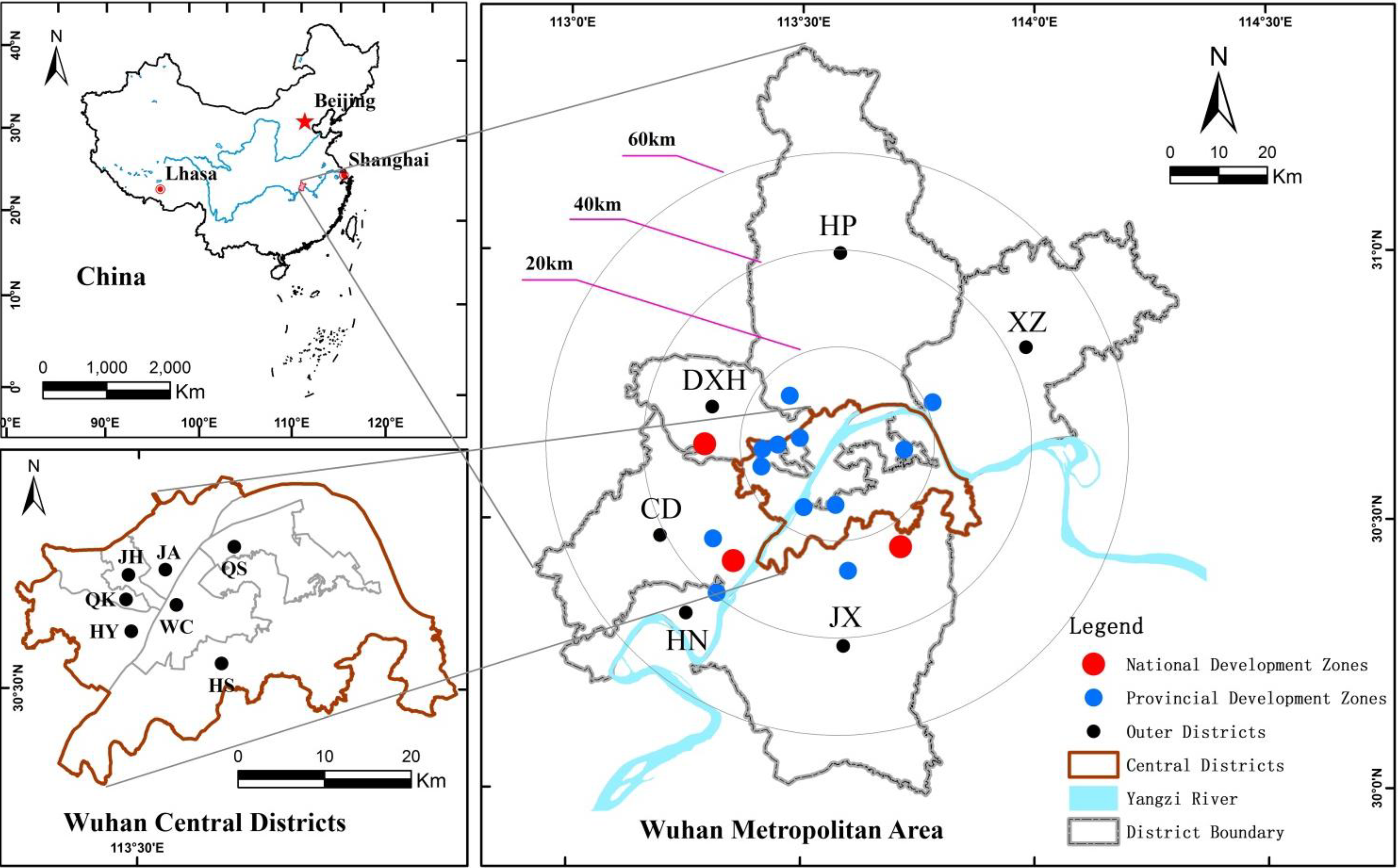
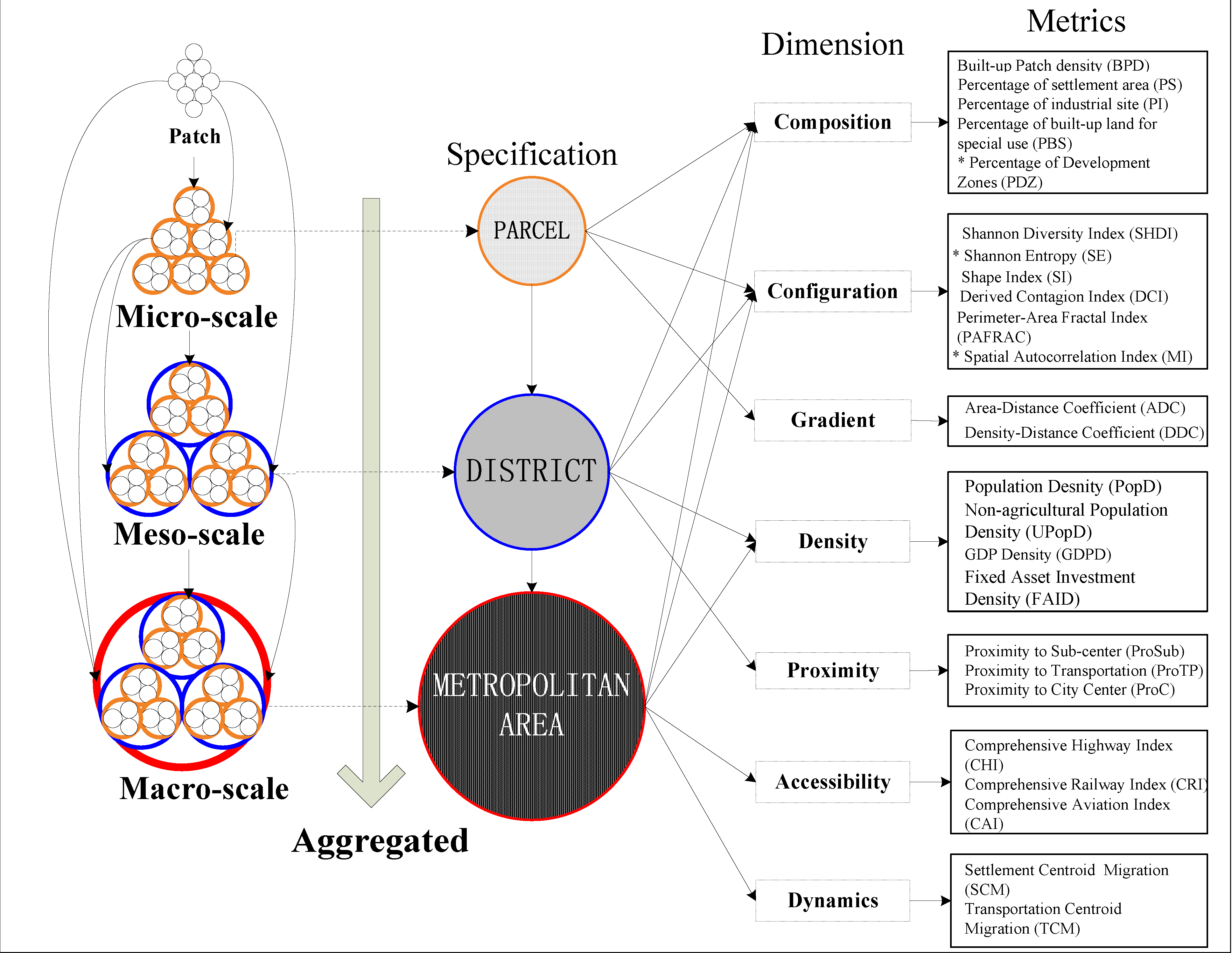






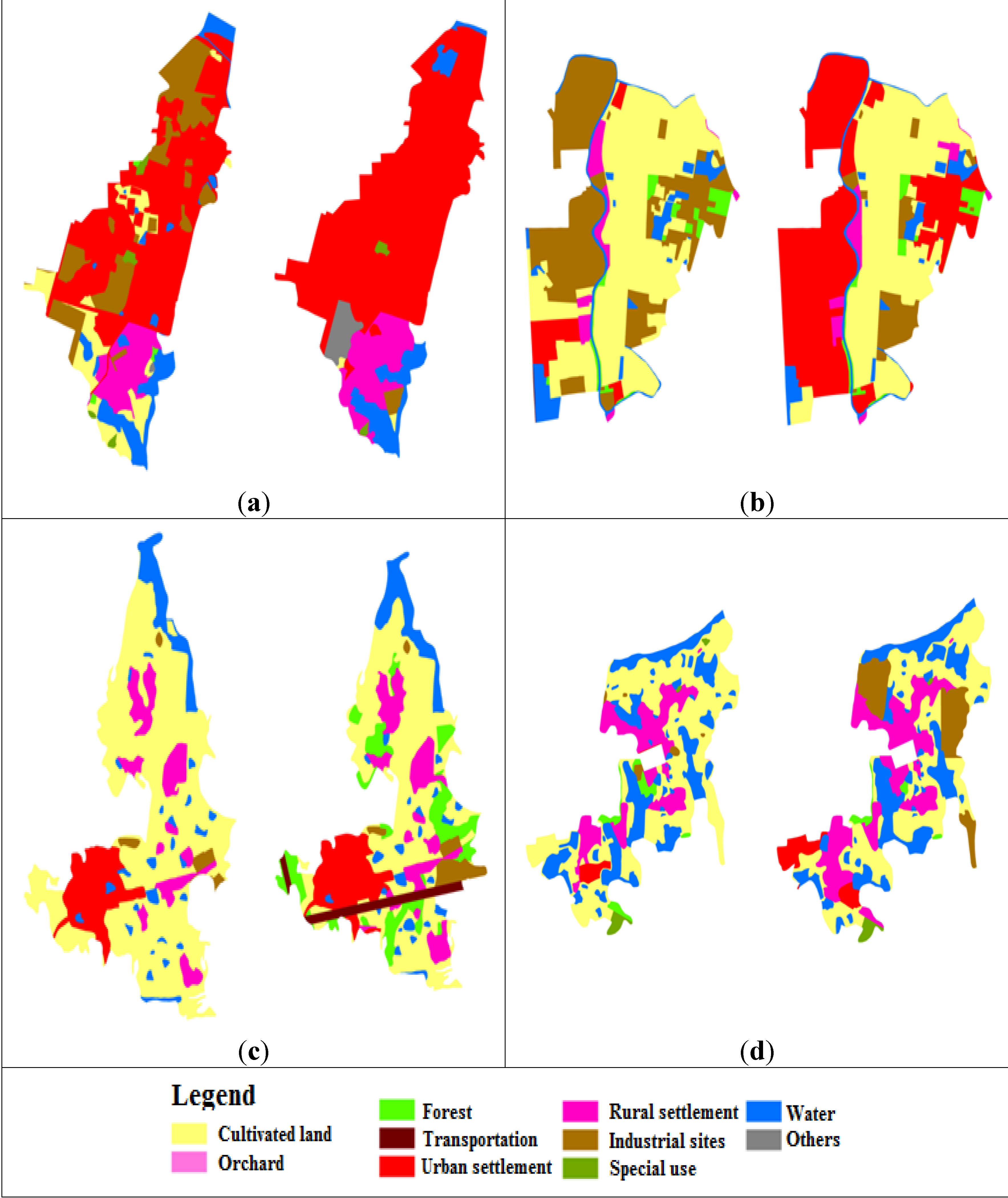
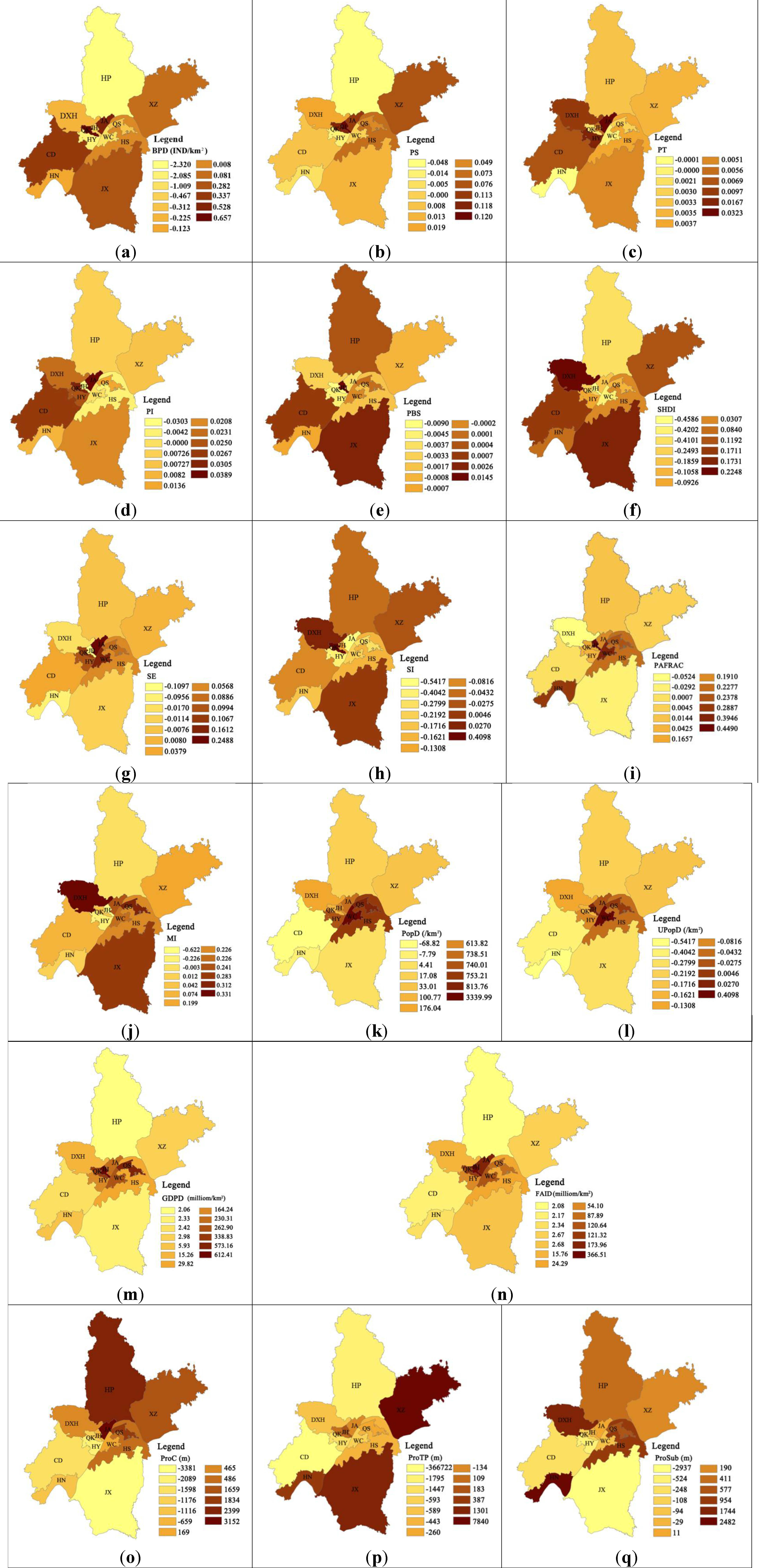

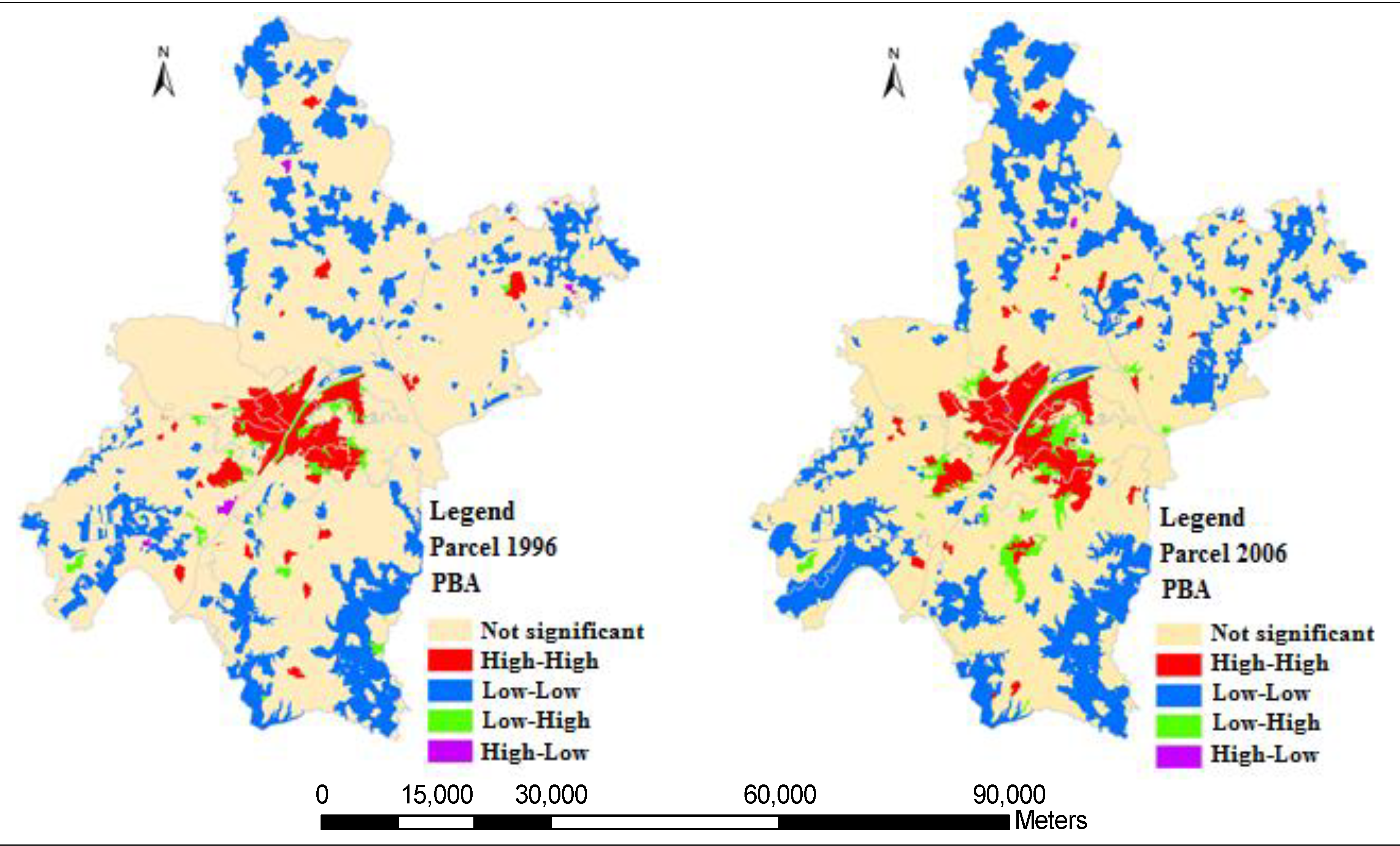
, Pij is the perimeter (m) of patch ij; aij is the area of patch ij; k is the number of patches in each parcel/district/metropolitan area;
Units: None; Range: 1 ≤ SI;Description: Shape index reflects shape complexity across a range of spatial scales. SI approaches 1 for shapes with very simple perimeters such as squares, and the larger the values are, the higher degree of irregular shape it is of.,
Pij is the perimeter (m) of patch ij; aij is the area of patch ij, N is the total number of patches in the landscape. M is the number of land uses i in the study area; n is the number of patches j.Units: None; Range: 1 ≤ FI ≤ 2;Description: Perimeter-area fractal dimension is a metric of space-filling between one- (unfilled) and two- (the fully-compact city) dimensions. Growth in fractal dimension over time is illustrative of compaction; decline suggests fragmentation. Fractal dimension measures have the added benefit of being scale-independent (Torrens, 2008).P is the population of the unit, AS is the area of unit
Units: /km2; Range: 0 ≤ PopD.Description: It reflects the density of population.P is the population of the unit, AS is the area of unit
Units: /km2; Range: 0 ≤ UPopD.Description: It reflects the density of non-agricultural population.GDP is the gross domestic product, AS is the area of unit
Units: million/km2; Range: 0 ≤ GDPD.Description: It reflects the density of economic output.FAI is the fixed asset investment, AS is the area of unit
Units: million/km2; Range: 0 ≤ FAID.Description: It reflects the density of fixed asset investment., Xi and Yi is the coordinates of parcels in a specific district. XS and YS is the coordinates of the weighted center of the district and the weights are assigned by the percentage of settlement area in each parcel. N is the number of parcels in the districts.
Units: m; Range: 0 ≤ ProSubDescription: It reflects the proximity to the settlement center., Where XC and YC is the coordinates of the weighted center of the district and the weights are assigned by the percentage of built-up land in each parcel. N is the number of parcels in the districts.
Units: m; Range: 0 ≤ ProSub;Description: It reflects the proximity to the settlement center., VHDP and VHDF are the standardized values calculated from two indicators -“Freight ton kilometers” and “passenger kilometers” recorded in the Statistical Yearbook of Wuhan through max-min normalization with the range from 0 to 1.
Units: none; Range: 0 ≤ CHI ≤ 1;Description: It reflects the capacity of highway transportation., VRDP and VRDF are the standardized values calculated from two indicators -“Freight ton kilometers” and “passenger kilometers” recorded in the Statistical Yearbook of Wuhan through max-min normalization with the range from 0 to 1.
Units: none; Range: 0 ≤ CRI ≤ 1;Description: It reflects the capacity of railway transportation., VADP and VADF are the standardized values calculated from two indicators -“Freight ton kilometers” and “passenger kilometers” recorded in the Statistical Yearbook of Wuhan through max-min normalization with the range from 0 to 1.
Units: none; Range: 0 ≤ CAI ≤ 1;Description: It reflects the capacity of aviation transportation., (XS1, YS1) and (XS2, YS2) are the coordinates of settlement centroids in 1996 and 2006 respectively and then the settlement migration distance SCM is obtained. The transportation migration distance TCM can also be estimated accordingly.
Units: m; Range: 0 ≤ SCM;Description: It reflects the spatio-temporal variation of settlement distribution., (XT1, YT1) and (XT2, YT2) are the coordinates of settlement centroids in 1996 and 2006 respectively and then the settlement migration distance TCM is obtained. The transportation migration distance TCM can also be estimated accordingly.
Units: none; Range: 0 ≤ TCM ≤ 1;Description: It reflects the spatio-temporal variation of transportation distribution.


























